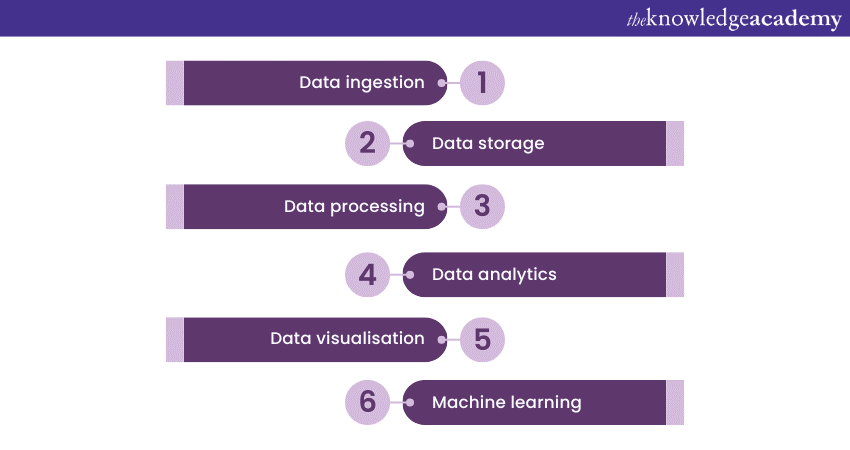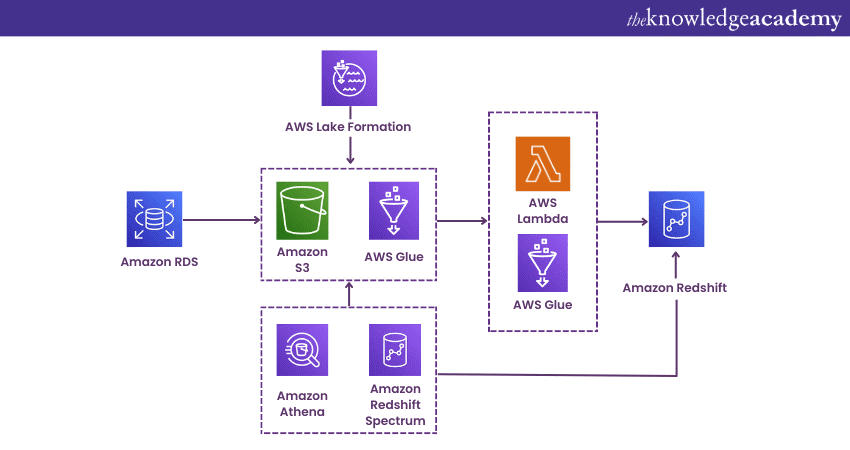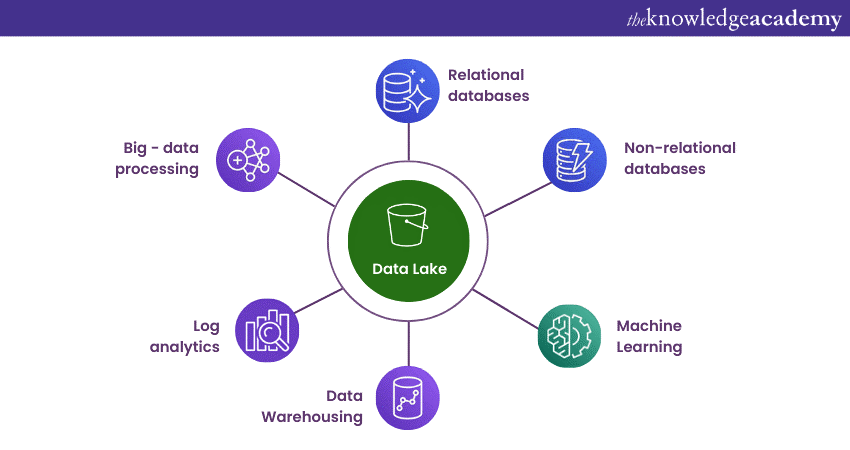We may not have the course you’re looking for. If you enquire or give us a call on 01344203999 and speak to our training experts, we may still be able to help with your training requirements.
Training Outcomes Within Your Budget!
We ensure quality, budget-alignment, and timely delivery by our expert instructors.

Big Data are large datasets that contain useful information, such as customer data. These datasets are generated over the internet every millisecond, thus managing Big Data is nearly impossible using traditional systems, and companies need specialised systems. Companies can use services like AWS Big Data Analytics to get useful business insights from Big Data.
According to Statista, AWS leads the cloud market with a 32 per cent share. Its AWS Architecture is perfectly capable of managing storage-intensive Big Data. Thus, it’s the right time to invest in its services and leverage AWS’s benefits. But how can these services be helpful in managing huge datasets? Let's find out. In this blog, you will learn and understand what AWS Big Data is, its key features and capabilities and how it helps manage Big Data.
Table of Contents
1) What is AWS Big Data?
2) How do AWS Big Data solutions work?
3) Key features and capabilities of AWS in managing Big Data
4) Available AWS tools for Big Data
5) Conclusion
What is AWS Big Data?
Big Data are large complex datasets which cannot be managed using conventional databases. These data are enormous in terms of volume, velocity and variety. So, it is tough for traditional Database Management Systems to handle these datasets. It needs specific Database Management Systems that are capable of managing such data.

AWS provides tools and services that can handle such vast chunks of data effortlessly. It helps organisations perform Data Management tasks like storage, Data Analysis and processing, etc. Its Cloud-based services help extract useful insights into your business using Big Data.
Numerous AWS Applications are employed for Big Data Management. This allows organisations to place complete trust in AWS services for their Big Data requirements without concerns about hardware, dependability, or security. AWS's seamlessly integrated services simplify the entire Big Data workflow, spanning from data extraction to end-user consumption. The following are the key reasons why AWS is chosen over other services:
a) Availability: AWS services remain accessible at every stage of the data flow, regardless of the data's scale.
b) Ingestion: Organisations demand rapid data retrieval from sources to storage. Various AWS services facilitate the extraction of data from sources in a matter of seconds.
c) Computing: AWS services harness powerful computing capabilities to execute tasks on Big Data efficiently.
d) Storage: Storing data securely, shielded from potential leaks or exposure, can be a challenging task for businesses. AWS storage services, such as Amazon S3, offer dependable and secure solutions for storing data while enabling data processing.
e) Security: Any security breach in the data pipeline can spell significant problems for businesses. AWS's integrable security services provide robust data security through the implementation of security policies and compliance measures.
How do AWS Big Data solutions work?
Amazon Web Services provides numerous solutions that cater to managing Big Data. These cutting-edge tools and technologies enable organisations to gather data efficiently, securely store, and meticulously analyse their expansive datasets. It also does so in a highly cost-effective manner.
There are various AWS benefits of leveraging these solutions. The suite of tools and services available from AWS comprehensively supports the full life cycle of Big Data. It seamlessly guides data through every stage, from initial collection right through to its ultimate utilisation. Let's see how these solutions work during various stages of Big Data lifecycle:
Collection
AWS provides a comprehensive suite of services designed to streamline structured and unstructured data collection. These services enhance the Big Data collection process by offering:
a) Kinesis Streams and Kinesis Firehose: Essential for ingesting streaming data in real-time, these tools are vital for applications that depend on quick insights and actions.
b) Integration with various data sources: AWS’s Big Data collection tools allow easy connection and integration with multiple services and data sources. Data can be imported manually or through APIs, facilitating efficient data collection and integration into Data Management systems.
Storage
AWS offers robust solutions for the scalable storage of Big Data, accommodating pre-processing and post-processing needs. The services provided include:
a) S3 and Lake Formation: Key for object storage, these services enable secure data storage and management.
b) S3 Glacier and backup: Tailored for backups and archival, they ensure data is both secure and retrievable over the long term.
c) Glue and Lake Formation: Crucial for data cataloguing and organization, they streamline Data Management processes.
d) Data exchange: This service supports transferring data from external sources and seamlessly integrating it into your existing storage and analytics operations.
Processing and analysis
In the AWS suite, processing and analysis services are essential for converting raw data into analytically valuable formats. This includes data sorting, aggregation, schema modification, and conversion into different formats.
Elasticsearch Service is optimal for operational analytics, offering real-time analysis for quick decision-making. Athena provides interactive analytics, allowing users to perform ad-hoc queries and deep data exploration. Redshift caters to Data Warehousing by enabling efficient data storage and complex analytics.
EMR is the service of choice for handling large-scale data processing, supporting extensive datasets with frameworks such as Hadoop and Spark. Kinesis Analytics excels in real-time analytics, processing streaming data instantly to provide immediate insights for urgent decisions.
Consumption and visualisation
In AWS, data consumption and visualisation tools are key to deriving and conveying insights from datasets. They enable detailed analysis and highlight critical or predictive elements.
Quicksight enhances Big Data visualisation in AWS by allowing businesses to create interactive dashboards and visualizations. Additionally, Deep Learning AMIs and Sagemaker bolster Machine Learning and Predictive Analytics, allowing businesses to effectively use data-driven insights.
Learn what is Data Streaming, Big Data Processing, and Data Storage Solutions with our Big Data On AWS Training - join today!
Key features and capabilities of AWS in managing Big Data
AWS Big Data Architecture is designed to facilitate seamless integration, scalability and security. From Data Warehousing to Data Analytics, it can effortlessly perform several functions. Some key features, capabilities and how they can help manage Big Data are explained below:
Warehousing of data

AWS offers one of its powerful services like Amazon Redshift, to help in effective Data Warehousing. It providesthe capability to examine massive datasets like Big Data. Apart from this, it also offers parallel processing and can perform multiple queries rapidly.
Machine Learning
AWS offers specific services to help you connect with Big Data's workflows. Organisations can create, instruct and launch Machine Learning models and scale up the capacity. This enables them to deploy various services rapidly and helps fulfil the demands of your product.
It also offers ready-made Artificial Intelligence (AI) models that can perform various tasks like recognising images, predicting demand for your products and services and Natural Language Processing (NLP). Some of the services that can help you do this are listed below:
a) Amazon Comprehend: It is a Natural Language Processing service that can train AI models using Machine learning (ML).
b) Amazon Forecast: Like its name, it is used for forecasting useful business metrics analysis using ML.
c) Amazon Rekognition: It is used for image processing and video analysis using ML.
Data Analytics and data processing
Organisations can perform enterprise-level Big Data Analysis using AWS. They can also perform certain tasks like cataloguing data, cleansing data and data governance, and protecting data using encryption keys. Here are the services that help you complete those operations:
a) AWS Lake Formation: It helps ensure that data is available for various analysis by creating data lakes.
b) AWS Glue DataBrew: It is used for preparing visual data and helps clean data for performing Data Analysis.
c) AWS Key Management Service (KMS): It helps secure data and applications by letting you build and manage encryption keys.
Data Analytics using data lake

Raw data can sometimes be tedious and hard on the eyes. It is hard to quickly get insights from observing texts and numbers. Organisation need something that can help them visualise things to offer more perspective. AWS Glue and QuickSight do precisely that. It can help transform boring data into visually pleasing insights. With QuickSight, organisations can analyse and visualise data, and here's how Glue helps:
a) Cataloguing data: It helps prep the data for analysis by streamlining it on a centralised data catalogue.
b) Transforming data: It helps convert data into different formats using a data lake.
c) Loading data: It helps load massive data to tables using simple commands.
Integration with other AWS services
Seamless integration is critical when choosing a provider for managing Big Data. The Big Data services of AWS help merge with its services very quickly. This allows businesses to use its serverless storage, messaging and computing features. Moreover, it also helps develop data pipelines from one end to the other.
Master data warehousing with our Data Warehousing Training On AWS Course and harness the power of Amazon AWS!
Available AWS tools for Big Data
In Big Data, having the appropriate tools is essential for addressing challenges. Converting the immense raw data into actionable and valuable insights is daunting, but it becomes an achievable objective with the proper resources at your disposal.
Data ingestion
Amazon Kinesis Firehose efficiently handles data compression, batching, encryption, and Lambda functions. It reliably transports real-time streaming data to Amazon's S3, ensuring seamless loading into data lakes, data stores, or analytics tools. Kinesis Firehose effortlessly adapts to the data processing demands of any organisation without the need for continuous administrative oversight.
AWS Snowball
AWS Snowball is a high-efficiency data transport solution that securely transfers large datasets from on-premises storage and Hadoop clusters into Amazon S3. Once you initiate a job via the AWS console, a Snowball device is automatically sent to your location.
Connect it to your network, install the Snowball client, and transfer your files and directories to the device. Once the transfer is complete, return the Snowball to Amazon Web Services, and they will seamlessly move your data into your designated S3 bucket.
Data storage
Amazon S3 serves as a repository for data gathered from corporate applications, websites, mobile devices, as well as Internet of Things (IoT) devices and sensors. It boasts unparalleled availability and can accommodate virtually any volume of data. Amazon S3 leverages the same scalable storage infrastructure that powers Amazon's global eCommerce operations, underscoring its reliability and robust capabilities.
AWS Glue
AWS Glue is a data service designed to streamline the Extract, Transform, Load (ETL) process by centralising metadata storage. With a few simple clicks in the AWS Management Console, Data Analysts can effortlessly create and execute ETL jobs. AWS Glue features an integrated data catalogue, serving as a durable metadata repository for all data assets. This enables Data Analysts to easily explore and query all their data from a unified perspective.
Redshift
Amazon Redshift allows analysts to execute intricate analytics queries on vast amounts of structured data at a fraction of the cost compared to traditional processing solutions, offering nearly 90 per cent savings. Additionally, Redshift incorporates Redshift Spectrum, enabling Data Analysts to execute SQL queries directly on exabytes of structured or unstructured data stored in S3, eliminating the need for unnecessary data movement.
Conclusion
We hope that after reading this blog, you have understood everything about AWS Big Data and how it is managed. Apart from this, you would have also learned about its key features and capabilities. Managing and analysing Big Data helps extract useful insights to drive your business performance.
Level up your AWS skills with our AWS Certification Courses and unlock your full potential!
Frequently Asked Questions

Learning AWS Big Data can advance your career by providing sought-after skills in managing and analysing large datasets, opening doors to roles in Data Engineering and Data Analytics. It positions you for opportunities in Cloud Computing, leading to career growth and advancement.

AWS Big Data is highly sought-after across industries for its capacity to manage large datasets, conduct real-time analysis, and deliver scalable solutions. It's a crucial skill for professionals in diverse sectors, reflecting its widespread demand in the job market.

The Knowledge Academy takes global learning to new heights, offering over 30,000 online courses across 490+ locations in 220 countries. This expansive reach ensures accessibility and convenience for learners worldwide.
Alongside our diverse Online Course Catalogue, encompassing 17 major categories, we go the extra mile by providing a plethora of free educational Online Resources like News updates, Blogs, videos, webinars, and interview questions. Tailoring learning experiences further, professionals can maximise value with customisable Course Bundles of TKA.

The Knowledge Academy offers various AWS Certification Courses, including the AWS Professional DevOps Engineer Training, AWS Solutions Architect Training and Big Data On AWS Training. These courses cater to different skill levels, providing comprehensive insights into AWS Architecture.
Our Cloud Computing Blogs cover a range of topics related to AWS Big Data, offering valuable resources, best practices, and industry insights. Whether you are a beginner or looking to advance your AWS Big Data skills, The Knowledge Academy's diverse courses and informative blogs have got you covered.

The Knowledge Academy’s Knowledge Pass, a prepaid voucher, adds another layer of flexibility, allowing course bookings over a 12-month period. Join us on a journey where education knows no bounds.
Upcoming Cloud Computing Resources Batches & Dates
Date
 AWS RoboMaker Training
AWS RoboMaker Training
Fri 26th Jul 2024
Fri 25th Oct 2024







 Top Rated Course
Top Rated Course



 If you wish to make any changes to your course, please
If you wish to make any changes to your course, please


